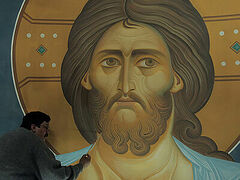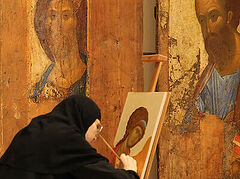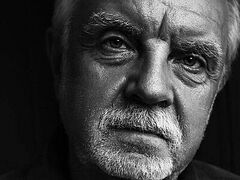In our conversation with iconographer Anatoly Aleshin, the instructor of the Icon Painting School of Moscow’s Theological Academy, one of the leading specialists in the area of fresco painting, we discussed why it is incorrect to speak about the icon painting canons; what inspires today’s iconographers in the absence of heated theological disputes of old times, and how to decorate a large church in two months. Among some of his projects are the wall paintings in the crypt of the Holy Hierarch St. Gregory of Novgorod in the St. Sophia Cathedral (Veliky Novgorod), the Trinity Cathedral of St. Pachomius monastery in Nerekhta, St. John of Kronstadt Cathedral in Hamburg (Germany), the church at the Russian Pilgrim’s Residence at the site of Baptism of Jesus Christ (Jordan), the churches in Diveyevo, and others
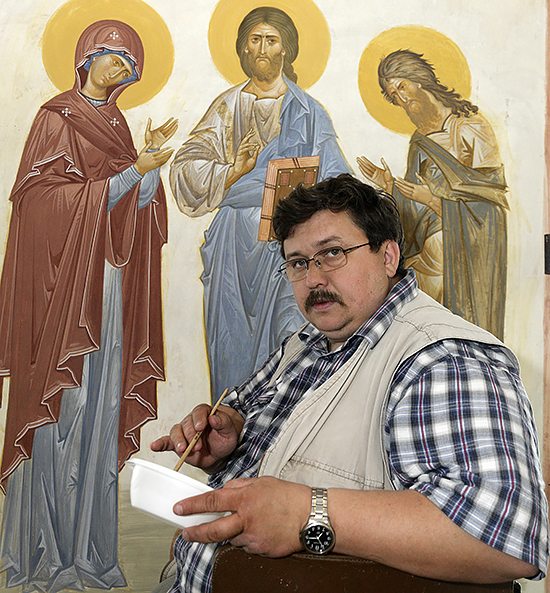 Anatoly Alyoshin, the iconographer
Anatoly Alyoshin, the iconographer
“The saint isn’t easily recognizable”
—Does apprenticeship still exist in modern church art? I mean, when you can literally recognize the work of the certain master’s apprentices, as well as pinpoint it stylistically (in the same way as we speak of “Dionisy and his studio”)?
—The apprenticeship of today rather presents itself in the fact that we thoroughly examine the examples of the ancient icon painting and strive to emulate them. This process has its own benefits and drawbacks. It is great to study the icons of great masters, learning the wonderful principles of their aesthetics and artistic concepts, or even adopt some techniques. On the other hand, it is unlikely that the blind imitation of the ancient forms can become the ultimate goal for a modern iconographer.
We live in an era of mass culture. Affordable lithographic images of icons became widely available from as early as the middle of the nineteenth century and this lowered the bar in iconography so much that it gradually became a craft. It caused well-known iconographers to pursue other art forms.
Generally speaking, the process of simplification in icon painting started even earlier than that, but beginning from the end of the last century we witnessed the widespread return to Byzantine and Old Russian icon painting.
Ancient icon painting, from the first centuries of its history to the fifteenth and sixteenth centuries, was developing in its own, peculiar way. I shouldn’t say it was a process of development (since that usually means a gradual advancement from basic to more mature stages), but rather that it existed in various forms historically framed within this or that historic epoch. New influencers would appear, because the icon painting, apart from the Word of God as the main source of inspiration, was also inspired by contemporary theological writings. We recall St. Gregory Palamas’ impact iconography.
It is somewhat different in modern icon painting. We are learning, if I may say so, the ABCs of icon painting, because in order to speak the “language of icons,” we have to first master it. This may take anywhere from twenty to thirty years. I can speak for myself that, at times, you think that you have already grasped certain elements of the art and even mastered them. Then, the next moment, when you glance back at the ancient icons, you suddenly realize how much deeper they are than your previous understanding of them. And you are up to another cycle of learning.
—It’s true that iconographers of old times were inspired by theological thought and even the heated disputes of their contemporaries. What is the situation today?
—There may no longer be heated arguments, but the Church dogmas are indisputable. We can be inspired by the works of the fathers from previous centuries. The iconographers of yesteryear and today are fully engaged and keenly attuned to the current situation in the church life. However, we also have to understand that, if an iconographer is an active member of the Church, that is good enough!
I don’t see anything that can become a game-changer in icon painting. At one moment I felt that the ancient icon art has said it all. On the other hand, it is an unworthy goal for an artist to keep producing carbon copies of the old examples all his life, even though you can’t go without them for quite some time. However, how will you overcome the harsh dependence on the original? A poet once said: “Beauty is happiness from grasping a form…” and “Spirit creates form,” as many theologians say. Form creation is an iconographer’s goal just as it is the search of beauty form from the perspective of the Church.
At that time, when I felt that the ancient icon had stated it all, and as I had already studied much by observing many ancient examples of iconographic art during my travels to the museums in our country and abroad, I came upon a small icon from the fourteenth century. Its style helped me to date it—it was part of a private collection. That’s when I understood the artistic journey of the iconographers in the fifteenth and sixteenth centuries. They didn’t have to invent the composition, since it had already been established in the earlier days when the painter’s task was to start at a certain theological thought and work to arrive at its artistic interpretation, making it easily recognizable later… Using these compositional paradigms, the iconographers interpreted them in such a way that the end result would be a new and innovative work of art. There are limitless numbers of icons for the Transfiguration of the Lord or any major feast, but when you look at them, you first notice how identical they are, down to the fabric folds. But the variations in coloristic design and composition are great enough to view each icon as a unique piece of art.
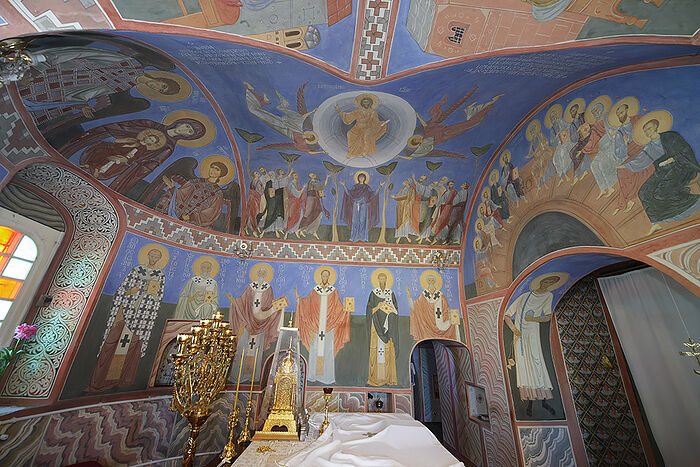 Painting of the Trinity Cathedral at the St. Pachomius monastery in Nerekhta.
Painting of the Trinity Cathedral at the St. Pachomius monastery in Nerekhta.
—It is considered bad manners to speak about the canon of iconography these days. And truly, its intended meaning was so beaten up and widely interpreted that everyone tries hard to use its synonyms instead.
—The use of a notion of the canon may be justified in the context of the icon painted in the 1980s, as there were attempts to separate the old icon painting from the academic painting style. However, the holy fathers did not use the notion of a “canonical icon.” The language of the icon wasn’t formed by any specific canons; its patterns of convention were necessary for the iconographer to be able to transmit the required theological content through the icon.
The language of iconography doesn’t allow for any associated memory of the material world; it makes us think about the otherworldly, heavenly realm. On the other hand, the icon convention is quite subtle as it speaks about saints who lived in our world, and even about God who became Man. If a painter crosses this fine line, it may result in oversimplification and the loss of important narratives. The masters of old were able to keep the balance even in the most primitive icons.
—Can we speak about the canon in terms of images, for example, how God the Father is painted or when the new iconography, such as “The Chernobyl Savior Icon”, is developed?
—I think we can speak about the canon from this perspective. Sure enough, the canon is not about how you paint but what you depict.
Even St. Basil the Great mentioned in his homily: Here I have told you about a martyr, and now you can see the painters’ depiction of his martyrdom; it will be a lot more informative than listening to my description.
I liked the comparison drawn by a film producer who said that it is harder to write great prose than a poem. At the same time, practically anyone can write a story or a narrative. But as Mayakovsky put it, in order to write a decent poem, one has to “sift through a thousand tons of verbal ore for the sake of one word .” Immediately I think of an icon. An icon is also a kind of spiritual poetry, since an iconographer has to search for expressive artistic tools to concisely present the art form. The task at hand is more complex than painting a landscape.
—Does it ever happen that you can’t grasp the character of a saint, and his icon doesn’t come together?
—Sure. I think any iconographer experiences that. Back in the 1990s, I worked in the St. Sophia’s crypt in Novgorod dedicated to the Holy Hierarch St. Gregory of Novgorod. It had medallion icon images of saints, brothers John and Gregory of Novgorod. I have read their Lives and formed my understanding of them by focusing on specific major events from their lives. For instance, speaking about St. John, I singled out the battle between the Novgorod residents and the people of Suzdal, where Archbishop John became famous for carrying the icon of the Mother of God of the Sign that was hit by an arrow. There was another story of him, almost a myth, about how he traveled to Jerusalem atop a demon. This was all that sank in about him. When I started painting his icon, the local restorers came by and said: “Hmmm, he is somewhat unrecognizable here.” One of the restorers brought in a typewritten collection of edifying stories written by St. John of Novgorod addressed to monks, laity, and clergy. I devoured it and, as a result of this reading, I was able to visualize this saint differently, as a man of a clear mind, capable of addressing anyone plainly and clearly, and who knew how to defend the truth. The following day, as I finished working at his icon, the restorers came by again and said: “This one is more like him!” By the way, this is an example of how useful the written word can be for the iconographer.
To be continued.

